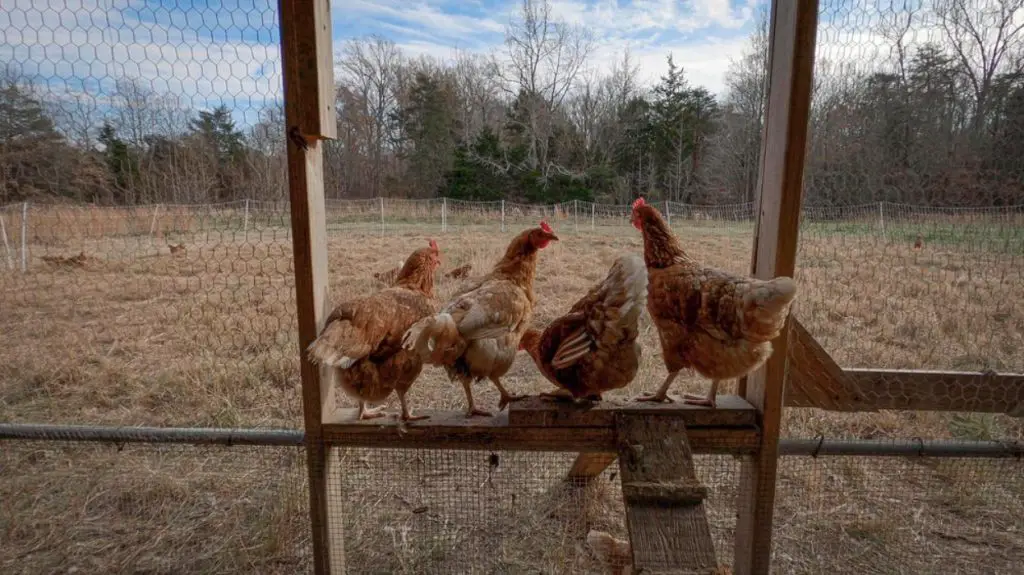Creating a chicken playground is a brilliant way to keep your flock active and engaged. In this article, we explore various DIY chicken playground ideas. These ideas are designed to promote the well-being of your chickens through fun and interactive activities. We’ll guide you through easy-to-implement, creative solutions that cater to chickens’ natural behaviors.
Contents
- 1 Importance of a Chicken Playground
- 2 How to Build on Your Chicken Playground Ideas
- 3 Safety Considerations and Maintenance
- 4 FAQ for DIY Chicken Playground Ideas
- 4.1 What are the benefits of implementing chicken playground ideas?
- 4.2 How much space do I need for a chicken playground?
- 4.3 Are chicken playgrounds safe for chickens of all ages and sizes?
- 4.4 What materials are best for building a chicken playground?
- 4.5 How often should the chicken playground be cleaned and maintained?
- 4.6 Can I build a chicken playground in a confined space?
- 4.7 What are some simple chicken playground ideas for beginners?
- 4.8 How do I ensure my chicken playground is engaging for the chickens?
- 4.9 Are there any specific safety concerns with chicken playgrounds?
- 4.10 Can chicken playground ideas be implemented in all climates?
- 5 Conclusion
Importance of a Chicken Playground
Keeping chickens isn’t just about providing food and shelter. It’s also about ensuring their overall happiness and health. A chicken playground plays a crucial role in this. It offers physical and mental stimulation, essential for a healthy and happy flock.
Enhancing Chicken Health and Wellbeing
A well-designed chicken playground is more than just a luxury. It’s vital to promoting your flock’s overall health and well-being. These playgrounds provide essential opportunities for exercise, which is crucial for maintaining physical health in chickens.
Jumping on perches, climbing ladders, or navigating obstacle courses enhances muscle strength and improves coordination and balance. This physical activity helps prevent obesity, a common issue in less active chickens, reducing the risk of health problems associated with excess weight.
Moreover, the mental stimulation offered by these playgrounds is vital. Chickens are intelligent creatures that require cognitive engagement. A playground filled with varying stimuli keeps their minds active and engaged. This is particularly important in preventing boredom, a common problem for chickens in confined spaces. Boredom can lead to negative behaviors such as feather picking or aggression. By providing a stimulating environment with different textures, colors, and interactive elements, you can help mitigate these issues.
The design of the playground also plays a crucial role in mental health. Incorporating elements that mimic a chicken’s natural environment can promote natural behaviors like foraging, pecking, and exploring. These activities keep chickens entertained and contribute to their emotional well-being.
A chicken playground is not just a place for physical activity but a comprehensive environment that caters to your chickens’ physical, mental, and emotional needs. By offering a variety of activities and stimuli, you can ensure a happier, healthier, and more active flock.
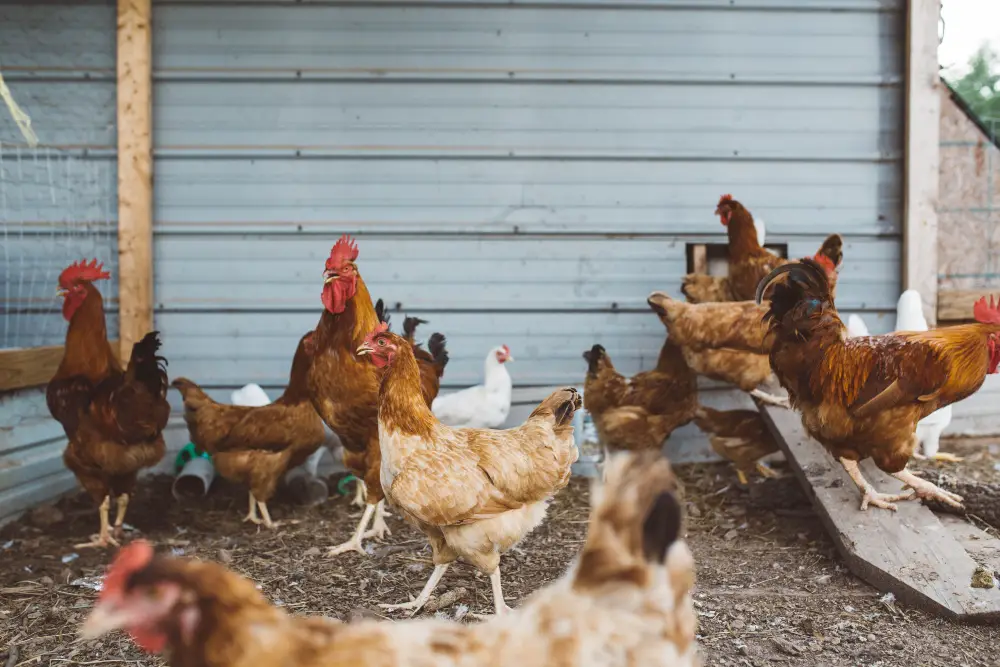
Boosting Egg Production and Quality
Incorporating chicken playground ideas into your coop can significantly impact your flock’s egg production and quality. Chickens in regular physical activity in playgrounds are generally healthier and more productive.
These chicken playground ideas include activities encouraging movement, such as climbing frames and hanging treats, which keep chickens fit and reduce stress levels. Lower stress levels in chickens are directly linked to higher egg production and better shell quality.
The variety of chicken playground ideas also contributes to enhanced egg quality. When chickens explore different textures and elements in their playground, they engage in natural behaviors.
These activities can lead to improved yolk color and taste. For instance, incorporating dust baths and foraging areas as part of your chicken playground ideas can promote natural behaviors crucial for your chickens’ well-being.
Moreover, chicken playground ideas can also include elements that mimic the challenges chickens face in a natural environment. For instance, balance beams or gently swaying perches encourage chickens to use and develop their natural balancing skills. It not only keeps them physically fit but also mentally sharp. Well-exercised and mentally stimulated chickens are known to lay eggs more consistently.
Implementing various chicken playground ideas isn’t just about keeping your chickens entertained. These playgrounds are critical in enhancing your flock’s physical and mental health, positively impacting their egg-laying capabilities.
Regular interaction with diverse and stimulating chicken playground ideas can increase egg production and improve egg quality, making it a rewarding investment for any chicken keeper.
How to Build on Your Chicken Playground Ideas
Chicken playgrounds are essential for your fowls to grow and develop healthily. Below are ways to make your chicken playground ideas into reality.
Essential Elements of a Chicken Playground
Creating an effective chicken playground involves more than just random structures. It’s about understanding and implementing key components that make the space safe and stimulating. Here, we delve into the essential elements of chicken playground ideas that should be considered to maximize the benefits for your feathered friends.
Safe and Stimulating Environment
Successful chicken playground ideas are founded on creating a safe and stimulating space. Safety is paramount. The entire playground area must be thoroughly inspected to ensure it is free from potential hazards.
It includes removing or securing any sharp objects, ensuring no toxic plants or substances are within reach, and verifying that all structures are free from small gaps that could trap a chicken. The structures within the chicken playground must be robust and reliable, able to withstand different weather conditions and the daily activities of an active flock.
Beyond safety, stimulation is key to an engaging chicken playground. Consider incorporating various textures, colors, and materials in your chicken playground ideas to keep your chickens curious and active.
It could include items like ropes for pecking, logs of varying sizes for climbing and balancing, and different surfaces for scratching. These variations keep the chickens physically and mentally engaged, encouraging natural behaviors like foraging and exploring.
Incorporating interactive elements that stimulate the senses is also an effective way to enrich the environment. It could involve adding bright, non-toxic colors to certain areas or structures, using different materials that create unique sounds when pecked or scratched, and even introducing movable elements that chickens can manipulate. These sensory experiences mimic the diverse stimuli chickens encounter in a more natural setting.
Furthermore, varying the layout and components of the chicken playground can help maintain interest and curiosity. Introducing new features or rearranging existing ones prevents the chickens from becoming bored with their environment.
A safe and stimulating environment is crucial in chicken playground ideas. It requires careful planning and a balance between ensuring physical safety and providing a variety of sensory and interactive elements. This combination promotes the well-being of your chickens and encourages natural behaviors, making the chicken playground a dynamic and enjoyable space for your flock.
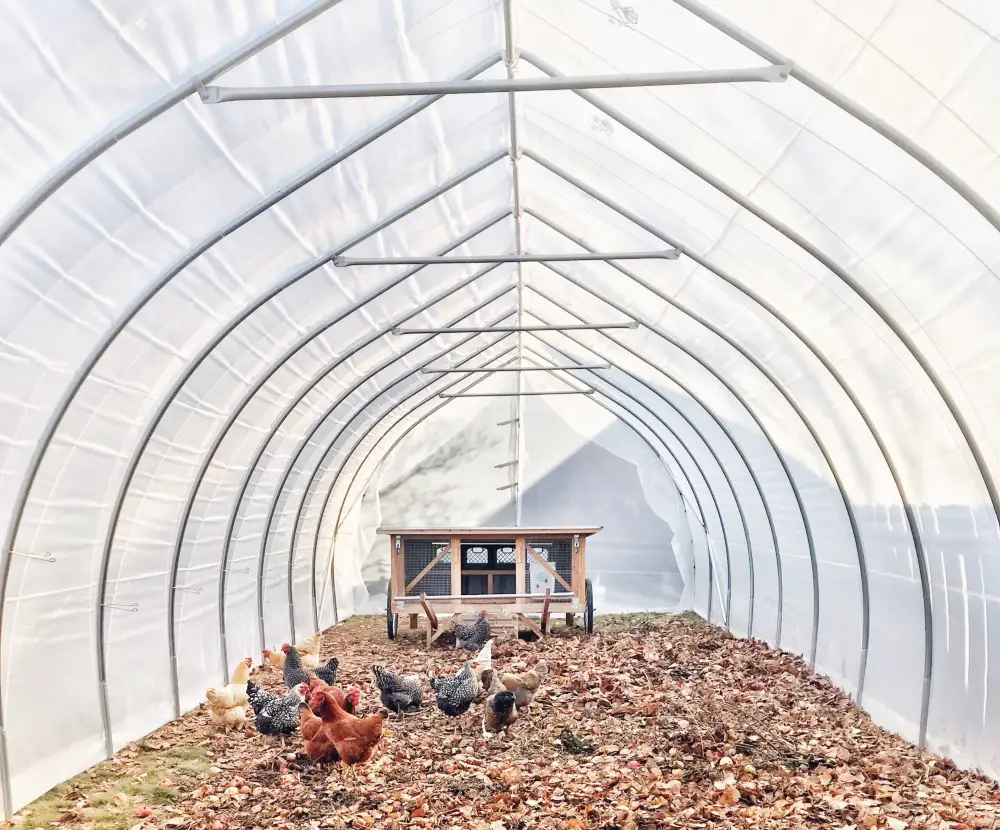
Varied Components for Physical Activity
A dynamic chicken playground is characterized by its diverse range of structures that promote physical activity. Each component is designed to encourage different types of movement, essential for your chickens’ physical health and agility.
- Perches for Jumping and Balancing
Perches are a fundamental aspect of chicken playground ideas. Offering perches of varying heights and sizes encourages chickens to jump and fly up to them, which is excellent for muscle development and maintaining a healthy weight. Additionally, balancing on these perches helps improve their coordination and strengthens their leg muscles. For a more challenging setup, consider installing perches at different angles and distances from each other.
- Ladders and Ramps for Accessibility
Incorporating ladders or ramps is a thoughtful way to ensure all chickens, including younger, older, or less able birds, can enjoy the playground. These elements provide easier access to higher areas and perches, ensuring that the playground is inclusive for every member of your flock. Ladders with varying rung spacing can also be a fun challenge for birds, promoting problem-solving skills.
- Swings for Fun and Coordination
Swings add a playful element to chicken playground ideas and serve a practical purpose. Hanging swings from different heights allows chickens to hop on and off, improving their coordination and balance. The gentle motion of the swings provides a unique physical challenge and can be highly entertaining for the chickens and their keepers.
Obstacle Courses for Varied Movement
Integrating obstacle courses into chicken playground ideas is an excellent way to elevate chickens’ physical activity and mental engagement. These courses simulate chickens’ natural challenges in the wild, encouraging various movements and enhancing their overall well-being.
- Tunnels for Exploration and Running
Including tunnels in the obstacle course offers a fun way for chickens to explore and run. These can be made from safe, sturdy materials like PVC pipes or wooden boxes. Tunnels encourage chickens to move swiftly from one end to the other, which not only aids their physical exercise but also satisfies their instinctual desire to explore enclosed spaces.
- Hoops for Jumping and Agility
Adding hoops at different heights and sizes presents an enjoyable challenge for chickens, prompting them to jump through them. This activity is excellent for improving their agility and coordination. Hoops can be hung from a frame or placed on the ground, and their positions can be changed regularly to keep the experience fresh and challenging.
- Platforms for Climbing and Perching
Platforms of varying heights and sizes can be strategically placed throughout the obstacle course. They encourage chickens to climb and balance, providing excellent exercise for their leg muscles. These platforms can also serve as perching spots, offering chickens a view of their surroundings and a sense of security as they often seek higher ground.
- Balance Beams and Bridges
Incorporating balance beams and bridges into the obstacle course adds another layer of challenge. Walking across narrow beams or swaying bridges requires focus and balance, aiding motor skills development. These elements can be created using sturdy wood or rope, ensuring they are safe and secure for the chickens.
- Interactive Elements for Mental Stimulation
You can include interactive elements within the obstacle course to enhance mental stimulation. It could involve puzzle feeders that require the chickens to work out how to access treats or objects that move or make noise when interacted with, adding an element of surprise and curiosity.
Areas for Dust Baths and Foraging
Incorporating areas for dust baths and foraging is a vital aspect of chicken playground ideas, as they closely mimic a chicken’s natural environment and behaviors.
- Dedicated Dust Bath Areas
Dust baths are not just a cleaning ritual for chickens; they are essential for maintaining good feather and skin health and are a natural way for chickens to control parasites. A dedicated dust bath in your chicken playground should contain a mix of fine sand, ash, and diatomaceous earth, which helps in effective cleaning and parasite control.
This area should be easily accessible and spacious enough for multiple chickens to use simultaneously. Enclosing the area with logs or stones can help contain the dust and define the space.
- Foraging Zones for Natural Behavior
Foraging is an instinctual behavior for chickens, and providing a designated foraging area in your chicken playground enhances this natural activity. This area can be filled with loose soil, leaves, and compost, allowing chickens to scratch and peck as they would in the wild. Hiding treats like seeds, mealworms, or vegetables in this zone encourages chickens to search for food, providing mental and physical stimulation.
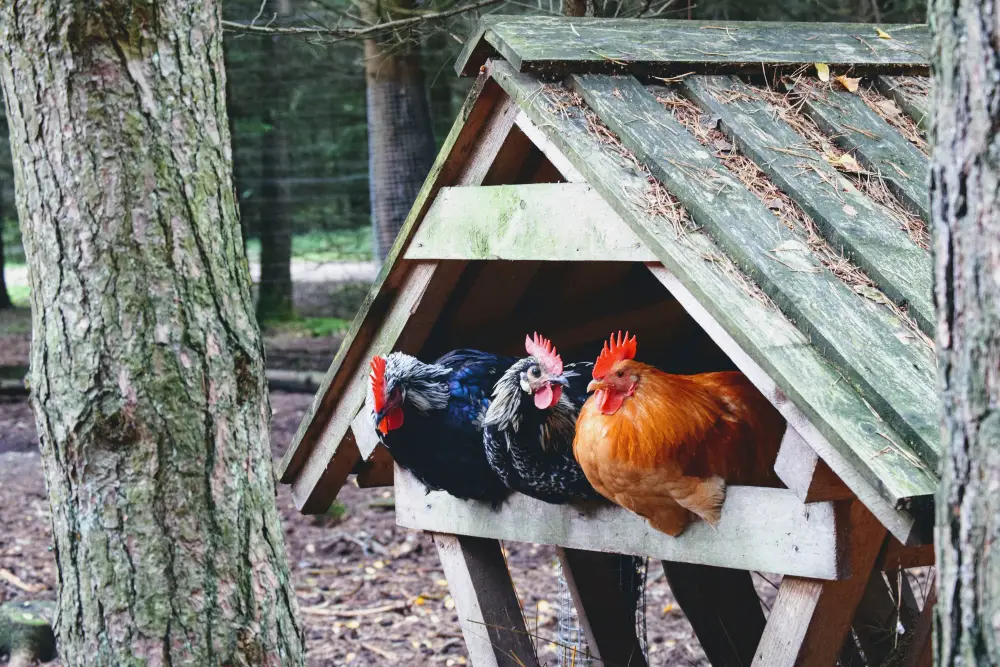
- Interactive Foraging Toys
To further enrich the foraging experience, consider adding interactive foraging toys to your chicken playground ideas. These toys can dispense treats when pecked or moved, adding an element of challenge and excitement to the foraging process. It also encourages problem-solving skills and keeps the birds engaged for extended periods.
- Variety in Foraging Areas
Creating various foraging areas with different textures and components can stimulate the chickens’ curiosity and exploration instincts. For example, one area could have more greenery and plants suitable for pecking, while another might have a different substrate that encourages digging. This variety entertains the chickens and provides a more enriching and natural foraging experience.
Creative Ideas for Chicken Playgrounds
When enhancing your flock’s environment, there’s a wealth of creative chicken playground ideas to explore. These ideas provide your chickens with an enjoyable space and ensure their physical and mental well-being.
1. Recycled Materials for Unique Structures
One of the most sustainable and creative chicken playground ideas involves using recycled materials. Old tires, wooden pallets, or unused children’s play equipment can be repurposed into climbing structures, perches, or shelters. This environmentally friendly approach adds a unique charm to your chicken playground.
2. DIY Jungle Gym for Chickens
Building a jungle gym for your chickens can be a fun project. Use sturdy wood to create a multi-level structure with ramps, swings, and hanging ropes. This type of setup encourages natural climbing and roosting behaviors and can be tailored to fit the size of your flock and available space.
3. Interactive Feeding Stations
Incorporating interactive feeding stations is another innovative chicken playground idea. These stations can include puzzle feeders or treat dispensers that require chickens to peck or scratch to release their food. It stimulates their minds and mimics the foraging behavior they would exhibit in the wild.
4. Natural Elements for Exploration
Integrating natural elements into your chicken playground ideas can significantly enhance the appeal and functionality of the space. Planting edible plants shrubs, or creating a small garden area within the playground offers chickens the opportunity to peck at fresh greens and insects, providing nutritional benefits and encouraging natural behaviors.
5. Water Features for Play
Adding a shallow water feature, like a small pond or bird bath, can be a delightful addition to your chicken playground. Chickens enjoy pecking at water and may even dip their toes on hot days. Ensure the water feature is shallow and safe to prevent any risk of drowning.
6. Seasonal Adaptations
Tailoring your chicken playground ideas to different seasons can keep the environment engaging throughout the year. For example, adding extra shade and water sources during summer or sheltered areas and windbreaks in the winter ensures your chickens can enjoy their playground year-round.

Building a Chicken Jungle Gym
Creating a chicken jungle gym is a fantastic way to enrich your chickens’ environment. It provides them with opportunities for exercise, exploration, and play. Here’s a step-by-step guide to building a jungle gym that will keep your flock active and entertained.
1. Planning the Jungle Gym
The first step in building a jungle gym for your chicken playground ideas is thorough planning. Begin by evaluating the available space in your chicken coop or yard. It’s essential to consider the size of your flock and ensure there’s enough room for all chickens to move around comfortably. Each chicken should have ample space to explore without feeling cramped.
When designing the layout, aim for a balance between complexity and usability. Incorporate various levels, ramps, and perches to create a multi-dimensional space. Think about how the chickens will move from one area to another and how each element of the jungle gym will be used.
A well-thought-out design for your chicken playground ideas can include lower perches and ramps for less agile chickens and higher, more challenging spots for more adventurous ones. Sketching a basic plan of the structure can be extremely helpful. This visual aid lets you adjust before construction begins, ensuring a practical and efficient design.
2. Gathering Materials
The choice of materials is crucial for building a durable and safe chicken jungle gym. Opt for weather-resistant woods like cedar or redwood, which are sturdy and resistant to rot and pests. Cedar, in particular, is a great option as it’s naturally insect-repellent, making it an excellent choice for outdoor structures.
For the framework, select robust posts that can support the weight and activity of your chickens. Planks are needed to create ramps and platforms, offering various levels for the chickens to explore. For perches, use dowels or natural branches, which provide a comfortable grip for the chickens’ feet. Ensure all materials are safe and non-toxic to chickens, as they tend to peck at their surroundings.
Incorporating recycled materials can add an eco-friendly and creative touch to your jungle gym. Old wooden ladders can be repurposed as ramps or perches, while wooden pallets can be transformed into platforms or frames. Using recycled materials reduces waste and adds character to your chicken jungle gym, making it a unique addition to your yard.
When gathering materials, consider the tools you’ll need for the construction. Essential tools like a saw, hammer, drill, and screws are basic. Ensuring you have all the necessary materials and tools before starting the project will make the building process smoother and more efficient.
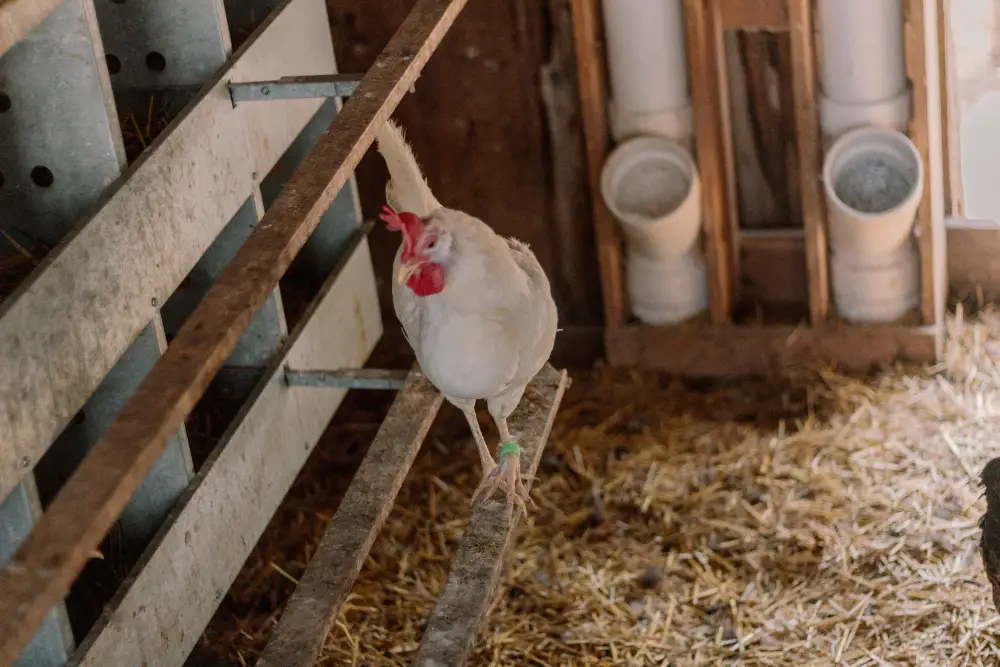
3. Building the Frame
The construction of a sturdy frame forms the foundation of your chicken jungle gym. Start by choosing a shape that complements your design and fits well within the available space.
A simple square or rectangular frame often works best, providing ample room for various activities and stability. The frame’s size should be proportionate to the number of chickens and the complexity of the structure you plan to build.
When building the frame, it’s crucial to ensure stability. Use strong corner brackets or joints to secure the frame’s corners. It provides robustness to the structure and prevents any wobbling or instability as the chickens play.
Additionally, anchoring the frame securely to the ground is essential to prevent tipping, especially in areas prone to strong winds or active flocks. You can use ground anchors, concrete bases, or heavy stones.
As you construct the frame, keep in mind the overall safety of the chickens. Smooth out any sharp edges or protruding screws and nails. A well-built frame not only supports the various elements of the jungle gym but also ensures the safety and security of your feathered friends as they explore and play.
4. Adding Levels and Ramps
Once the frame is in place, the next step is to install platforms at different heights. These platforms create levels within the jungle gym, allowing chickens to jump, climb, and perch at various elevations. When choosing the heights of these platforms, consider the abilities of your chickens. Younger or less agile chickens might prefer lower platforms, while more adventurous birds enjoy higher spots.
Connecting these levels with ramps or steps is essential for accessibility. Design ramps with a gentle incline, making them easy for all chickens to use. The ramps’ width should allow chickens to pass each other comfortably.
To enhance safety and usability, consider adding textured materials to the ramps. Hardware cloth or non-slip strips provide better grip, reducing the risk of slipping, especially in wet conditions. This addition is practical and adds extra care for your chickens’ well-being.
Incorporating steps or staggered platforms can also add variety to the jungle gym. These elements can be spaced to encourage chickens to hop from one level to another, further promoting exercise and play.
5. Installing Perches and Swings
Integrating perches and swings is a crucial aspect of chicken playground ideas. Perches provide a natural and necessary resting place for chickens, replicating their instinct to roost in trees. Use materials like dowels, branches, or bamboo poles for creating perches.
These should be fixed securely at various heights and angles throughout the jungle gym, offering various perching options for the chickens. This variation encourages more movement as the chickens hop from perch to perch.
Adding swings to your chicken playground ideas brings fun and additional exercise opportunities. Swings made from ropes or repurposed old tire swings can be a delightful addition.
As the chickens balance on these swings, they engage different muscle groups, enhancing their coordination and strength. Ensure that the swings are hung at a safe height and are stable enough to support the weight of the chickens.
6. Ensuring Safety
The safety of your chickens should always be the top priority in your chicken playground ideas. After constructing the jungle gym, a thorough inspection is necessary to identify and rectify potential hazards.
Check the entire structure for sharp edges, splinters, or loose components. All such issues should be addressed immediately to prevent injuries. Sand down any rough areas to smooth the surfaces and secure all parts firmly to ensure stability.
Pay special attention to the materials used in the construction. Ensure that everything is non-toxic and chicken-friendly. Regular maintenance checks ensure ongoing safety, as wear and tear can occur over time.
7. Final Touches
Once the basic structure of your chicken jungle gym is complete, adding final touches can significantly enhance its appeal and functionality. These additions are vital in keeping the playground exciting for your chickens.
Consider hanging toys, like bells or colorful objects, which can attract the chickens’ attention and encourage playful behavior. Mirrors can also be fascinating for chickens, providing entertainment and stimulation.
Incorporating pecking blocks or treat dispensers adds another level of engagement to your chicken playground ideas. These can be filled with treats or food that chickens need to work to access, promoting natural foraging behavior. Such features keep the chickens occupied and encourage physical activity and mental alertness.
Safety Considerations and Maintenance
When implementing chicken playground ideas, prioritizing safety and regular maintenance is crucial for the well-being of your flock. Ensuring that the playground remains a secure and enjoyable space requires ongoing attention and care.
Regular Safety Checks
Consistent safety inspections are essential in any chicken playground idea. Regularly examine the entire structure for potential hazards like loose screws, broken parts, or exposed sharp edges. It includes checking perches, swings, ramps, and any interactive elements for stability and wear. Any issues found should be addressed immediately to prevent injuries to the chickens. It’s also essential to ensure the playground is free from toxic plants or substances that might harm your chickens.
Maintaining a Clean Environment
Cleanliness is vital in a chicken playground. Regular cleaning helps prevent the buildup of droppings and debris, which can attract pests and lead to health issues. Disinfecting the playground elements periodically can also prevent the spread of diseases. Using chicken-friendly cleaning products is essential to maintain a safe environment.

Weatherproofing and Durability
Weatherproofing the structures is important to ensure the longevity of your chicken playground ideas. Treat wooden components with a non-toxic sealant to protect them from moisture and decay. Check and reinforce areas vulnerable to extreme weather conditions, like heavy rain, strong winds, or intense sun.
Updating and Adapting the Playground
Regular maintenance is also an opportunity to update and adapt the chicken playground. Changing the layout or adding new features can reinvigorate the space, keeping it interesting and stimulating for the chickens. It could involve introducing new perches, altering the obstacle course, or adding seasonal decorations.
Monitoring Chicken Behavior
Pay attention to how your chickens interact with the playground. Observing their behavior can provide insights into the elements they enjoy most and what needs to be changed or improved. Ensuring all chickens can use and enjoy the playground is key to its success.
Safety considerations and regular maintenance are integral parts of chicken playground ideas. By conducting frequent inspections, maintaining cleanliness, weatherproofing structures, and being responsive to the needs and behaviors of your chickens, you can ensure that your chicken playground remains a safe, healthy, and engaging environment for your flock.
FAQ for DIY Chicken Playground Ideas
What are the benefits of implementing chicken playground ideas?
Chicken playground ideas offer numerous benefits, including improved physical health, mental stimulation, and enhanced egg production in chickens. By providing various activities and structures, these playgrounds keep chickens active, engaged, and less prone to behavioral issues.
How much space do I need for a chicken playground?
The space required for chicken playground ideas can vary. It largely depends on the size of your flock and the type of features you want to include. Even small yards can have effective playgrounds with creative design and space utilization.
Are chicken playgrounds safe for chickens of all ages and sizes?
With proper planning and design, chicken playground ideas can cater to chickens of all ages and sizes. Including elements like low ramps and accessible perches ensures that younger and less agile chickens can also enjoy the playground.
What materials are best for building a chicken playground?
Weather-resistant woods like cedar or redwood are ideal for chicken playgrounds. Recycled materials like old tires or wooden pallets can also be used. Ensure all materials are safe and non-toxic for chickens.
How often should the chicken playground be cleaned and maintained?
Regular cleaning and maintenance are crucial for keeping the playground safe and hygienic. A monthly check for potential hazards and a thorough cleaning schedule can help maintain the playground’s condition.
Can I build a chicken playground in a confined space?
Absolutely! Chicken playground ideas can be adapted to fit smaller spaces. Vertical structures like tall perches or multi-level ramps can maximize the use of limited areas.
What are some simple chicken playground ideas for beginners?
For beginners, start with basic elements like perches, a dust bath area, and simple ramps. As you gain confidence, you can add more complex features like swings or an obstacle course.
How do I ensure my chicken playground is engaging for the chickens?
Keep the playground diverse with a range of activities. Observe your chickens’ interactions with the playground and adjust the elements based on their preferences. Regularly changing the layout or adding new features can keep the playground engaging.
Are there any specific safety concerns with chicken playgrounds?
The primary safety concerns include ensuring the stability of structures, removing sharp edges, and using non-toxic materials. Regular safety inspections are crucial to addressing these concerns.
Can chicken playground ideas be implemented in all climates?
Yes, with appropriate modifications for weatherproofing and seasonal adjustments, chicken playground ideas can be implemented in various climates. Add shade and water features for hot climates and ensure adequate shelter and wind protection in colder regions.
Conclusion
Incorporating chicken playground ideas into your backyard coop is more than a fun project. It’s an investment in the health and happiness of your flock. These playgrounds offer essential physical and mental stimulation from simple perches to elaborate obstacle courses. They help prevent boredom, encourage natural behaviors, and even improve egg production.

